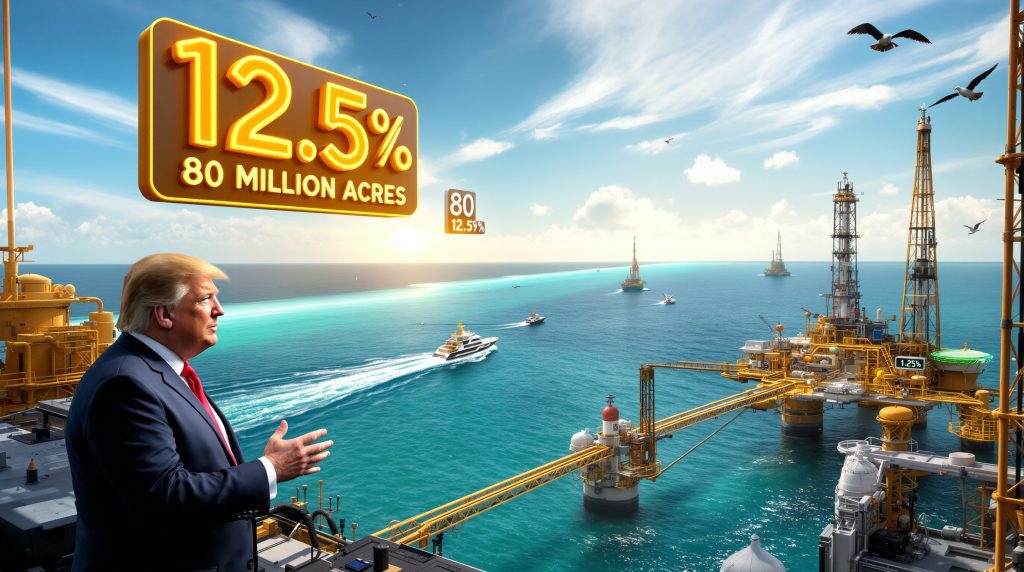Understanding the Strategic Framework Behind America's Most Ambitious Offshore Energy Initiative
The Trump administration's comprehensive offshore leasing program establishes a fundamentally new approach to U.S. energy development, centered on competitive fiscal terms designed to maximise industry engagement while generating substantial federal revenues. This historic initiative reduces the federal royalty rate to 12.5% from the previous 18.75%, representing a 33% decrease in fiscal burden that positions American waters competitively against international offshore regions.
The program operates under the One Big Beautiful Bill Act framework, providing congressional-level certainty that extends through 2040. Furthermore, this legislative foundation differs significantly from previous discretionary leasing arrangements, offering operators the regulatory predictability essential for multi-billion dollar deepwater investments that typically require 7-10 years from lease acquisition to first production.
What Makes This Gulf of Mexico Auction Historically Significant?
The December 10, 2025 lease sale represents the largest Gulf of Mexico offering in nearly a decade, encompassing 80 million acres across 14,000 individual tracts spanning federal waters from 3 to 231 miles offshore. This unprecedented scale dwarfs recent offerings and establishes the foundation for a 30-auction program scheduled through 2040.
Critical Auction Parameters:
- Total Coverage: 80 million acres across multiple water depths
- Tract Availability: 14,000 individual parcels
- Minimum Bid Requirement: $25 per acre
- Geographic Range: Shallow waters to ultra-deepwater zones
- Program Duration: 15-year timeline with predictable scheduling
The sale includes strategically located areas adjacent to major operational projects, including Shell's Whale development and Chevron's Anchor project in Alaminos Canyon and Green Canyon blocks. This proximity to existing infrastructure provides operators with immediate access to established pipeline networks and processing facilities, significantly reducing development costs and timeframes.
Historical context reveals that individual Gulf lease sales have generated revenues ranging from $100 million to $9.5 billion, depending on oil price environments and industry demand. The 2022 Gulf Lease Sale 257 generated approximately $312.7 million from 89 leased tracts, while the 2008 pre-Deepwater Horizon sale reached $3.1 billion during more favourable market conditions.
The American Petroleum Institute characterised the reduced royalty rate as a competitive step designed to revive investment in deepwater exploration that had been hindered by previous fiscal terms. In addition, industry participants recognise that the fixed leasing calendar addresses critical requirements for long-cycle projects requiring regulatory predictability over multi-decade investment horizons.
How Does the 12.5% Royalty Rate Compare Globally?
The Trump 12.5% gulf oil auction establishes highly competitive fiscal terms when analysed against international offshore jurisdictions. The statutory minimum rate provides operators with predictable baseline costs whilst maintaining federal revenue generation through complementary taxation mechanisms.
International Fiscal Comparison:
| Offshore Region | Primary Royalty | Additional Taxes | Combined Effective Rate |
|---|---|---|---|
| U.S. Gulf of Mexico | 12.5% | Federal/state corporate tax | 21-25% |
| Norway North Sea | 20-28% | 78% petroleum tax | 60-70% |
| UK North Sea | 10-40% (tiered) | Ring fence corporation tax | 50-65% |
| Brazil Pre-salt | 5-15% (tiered) | Special participation fees | 35-50% |
| Australia Commonwealth | 10-12.5% | Petroleum resource rent tax | 45-50% |
| Canada Federal | 5-12.5% | Income and resource taxes | 35-45% |
The U.S. Gulf's combined fiscal burden of approximately 21-25% positions American waters competitively against mature North Sea basins whilst remaining higher than Brazil's pre-salt developments, which have attracted aggressive international bidding through lower initial fiscal take. This competitive positioning addresses key concerns from international E&P companies that had shifted capital allocation toward South American developments offering more favourable terms.
Norway's 60-70% combined effective rate reflects the country's mature fiscal regime designed to capture maximum resource rents from established high-productivity fields. However, the UK's tiered system ranges from 50-65% depending on field characteristics and production levels. Australia's petroleum resource rent tax adds significant fiscal burden to the base royalty rate, creating combined effective rates of 45-50%.
Recent prolific discoveries in Guyana (Liza, Payara, Yellowtail fields) have attracted major operator investment partly due to significantly lower royalty rates of 2% on shallow-water developments, demonstrating competitive pressure the U.S. Gulf faces from alternative geographies offering more favourable terms.
Which Major Operators Are Positioning for Maximum Impact?
Industry intelligence indicates that established Gulf producers have strategically expanded capital allocation in anticipation of the new leasing framework. Chevron, Shell, and BP have already increased Gulf capital budgets according to industry reports, positioning themselves to capitalise on expanded opportunities under the competitive fiscal structure.
Strategic Positioning by Operator Category:
Integrated Majors (ExxonMobil, Chevron, Shell, BP):
- Access to multi-billion dollar project funding capabilities
- Established deepwater technical expertise and operational experience
- Existing offshore infrastructure ownership and pipeline networks
- Ability to cross-subsidise exploration from global operations
- Established regulatory relationships and permitting experience
Independent Producers (Murphy Oil, Occidental, focused E&P companies):
- Lower cost structure enabling smaller, marginal fields to achieve economic viability
- Capability to monetise less-explored acreage rejected by major operators
- Reduced exploration overhead through focused geographic concentration
- Potential capital constraints for ultra-deepwater development requirements
International Players (Equinor, TotalEnergies, Eni, Woodside):
- Access to international capital and advanced deepwater experience
- Technical expertise from other global basins (North Sea, West Africa, Brazil)
- Opportunities for joint venture arrangements with domestic operators
- May require infrastructure partnerships due to limited U.S. Gulf presence
Service Sector Expansion Opportunities:
- Drilling Services: Increased demand for floating rigs and specialised equipment
- Well Completion: Enhanced requirements for deepwater completion technologies
- Subsea Engineering: Installation and maintenance of underwater infrastructure
- Project Management: Consulting and technical services for complex developments
Current Gulf of Mexico production accounts for approximately 15% of total U.S. crude output, with deepwater projects representing some of the nation's most technically advanced and productive operations. Furthermore, the expanded leasing program aims to maintain and potentially increase this contribution over the coming decades.
Shell's Whale deepwater project serves as a modern benchmark for development in similar lease areas, demonstrating technical feasibility and operational excellence in Alaminos Canyon blocks. Chevron's Anchor project in Green Canyon provides another operational model for large-scale deepwater development, showcasing scalability and capital efficiency for future developments.
What Economic Impact Will This Generate for Federal and State Revenues?
The 30-auction program spanning 15 years creates substantial revenue generation potential for federal and state governments through the established Gulf of Mexico Energy Security Act (GOMESA) framework. Historical auction performance provides baseline projections for long-term revenue streams.
Revenue Distribution Structure:
| Revenue Recipient | Allocation Percentage | Primary Use |
|---|---|---|
| Federal Treasury | Primary recipient | General federal revenue |
| Gulf Coast States | 37.5% of revenues | Coastal restoration, infrastructure |
| Land and Water Conservation Fund | Dedicated allocation | Conservation and land acquisition |
| Historic Preservation Fund | Specified contribution | Historic site preservation |
Gulf Coast State Benefits
The four Gulf Coast states (Louisiana, Texas, Mississippi, Alabama) receive direct financial support through the 37.5% GOMESA allocation, providing dedicated funding for:
- Coastal Restoration Projects: Critical infrastructure protection against subsidence and sea-level change
- Hurricane Preparedness: Disaster resilience infrastructure investment
- Economic Development: Regional infrastructure and industrial support
- Environmental Protection: Marine habitat conservation and restoration
Louisiana historically receives the largest share due to production proximity and extensive coastal zone management responsibilities. The state utilises GOMESA revenues for comprehensive coastal restoration projects addressing land loss and environmental degradation caused by historical resource extraction activities.
Revenue Mechanics and Timeline
Operators pay minimum bid amounts of $25 per acre plus annual rental fees during non-producing lease periods, which typically extend 5-10 years through exploration and development phases. Upon achieving production, operators transition to royalty-based payments at 12.5% of production value, creating long-term revenue streams extending decades beyond initial lease acquisition.
The fixed 30-auction schedule provides Treasury with predictable revenue streams over the 15-year horizon, enabling long-term federal budget planning and reducing revenue volatility caused by ad-hoc leasing decisions. This predictability supports both immediate fiscal planning and strategic infrastructure investment across federal and state levels.
How Will This Affect U.S. Oil Production and Energy Independence?
The expanded Gulf leasing program directly supports U.S. energy security objectives by maintaining and potentially expanding domestic offshore production capacity. Current Gulf operations contribute approximately 15% of total U.S. crude oil output, with deepwater projects representing the most technically advanced and productive domestic operations.
Production Sustainability Framework:
Reservoir Quality and Productivity:
- Gulf formations offer exceptional high-productivity potential
- Proven deepwater reserves support long-term development
- Advanced recovery technologies maximise field economics
- Multiple pay zones provide development flexibility
Infrastructure Advantages:
- Established pipeline networks reduce development costs
- Existing processing facilities support rapid production startup
- Mature service sector provides technical expertise
- Strategic geographic positioning for export markets
Development Timeline Considerations
Deepwater projects typically require 7-10 years from lease acquisition to first production, suggesting meaningful production impact from the current program beginning 2032-2035 for early-awarded leases. The 2025-2040 program timeline aligns with industry development cycles, ensuring continuous lease availability throughout extended project lifecycles.
Strategic Energy Security Benefits:
Increased domestic production capacity provides strategic flexibility in international energy relationships and reduces import dependency. Recent agreements with China and South Korea for increased U.S. energy purchases demonstrate how domestic production capacity translates into international market advantages and enhanced energy diplomacy options.
The predictable leasing framework supports investment stability that extends beyond immediate development opportunities, enabling strategic positioning for future energy market developments. As global energy markets continue evolving, domestic production capacity provides supply chain resilience and price stability buffers.
What Are the Environmental and Regulatory Considerations?
The Trump 12.5% gulf oil auction operates within comprehensive environmental frameworks whilst streamlining approval processes for qualified operators. All lease areas undergo rigorous environmental analysis, with sensitive marine habitats and protected areas excluded from offerings.
Environmental Safeguard Implementation:
Protected Area Exclusions:
- Sensitive marine habitats remain protected from development
- Marine protected areas excluded from lease offerings
- Critical species breeding grounds receive special protection
- Coral reef systems and essential fish habitat protections maintained
Operational Environmental Requirements:
- Advanced blowout prevention systems mandatory for all operations
- Real-time environmental monitoring protocols required
- Seasonal restrictions protect marine mammal migration patterns
- Enhanced safety systems exceed historical operational standards
Technology and Safety Standards
Modern offshore technology significantly reduces environmental risks compared to historical operations through enhanced safety systems, reduced surface footprints, and advanced environmental monitoring capabilities. Current drilling systems incorporate multiple redundant safety mechanisms and real-time environmental compliance monitoring.
The regulatory framework balances resource development with environmental protection through science-based decision-making processes. Environmental impact assessments evaluate potential ecosystem effects whilst incorporating best available scientific information and stakeholder input.
Regulatory Streamlining Benefits:
The predictable leasing schedule reduces regulatory uncertainty whilst maintaining environmental compliance requirements. Operators benefit from consistent permitting timelines and clear regulatory expectations, supporting more efficient project planning and development cycles.
How Does This Integrate with Alaska's Cook Inlet Development?
The Gulf program operates alongside a renewed Alaska drilling policy shift featuring six Cook Inlet lease sales planned between 2026 and 2032. This dual-basin approach diversifies U.S. offshore production whilst supporting Alaska's energy economy and addressing Arctic resource development considerations.
Alaska Program Components:
- First Sale: March 2026 launch
- Total Sales: Six auctions through 2032
- Fiscal Terms: 12.5% royalty rate matching Gulf structure
- Strategic Importance: Arctic resource development and geopolitical positioning
The Alaska component addresses both domestic energy security and geopolitical considerations, particularly regarding Arctic resource competition with other nations. The consistent 12.5% royalty rate across both regions provides operators with fiscal certainty and enables resource allocation decisions based on geological and logistical factors rather than regulatory differences.
Regional Economic Integration
Alaska's offshore development supports state economic diversification whilst providing operators with additional resource base options. The Cook Inlet program represents a reversal from previous administration restrictions and reinforces Alaska's strategic role as both an energy hub and Arctic gateway.
The dual-region approach creates operational synergies for companies active in both basins, enabling technology transfer and operational expertise sharing between Gulf and Alaska operations. This geographic diversification reduces operator risk whilst maximising domestic resource development potential.
What Investment Opportunities Does This Create?
The comprehensive 15-year program creates multiple investment pathways across the offshore energy value chain, extending beyond direct lease participation to encompass supporting industries and infrastructure development opportunities.
Primary Investment Categories:
Direct Lease Acquisition:
- Primary acreage positions in high-potential blocks
- Strategic positioning near existing infrastructure
- Joint venture participation opportunities for risk sharing
- Portfolio development across multiple lease areas
Infrastructure and Service Expansion:
- Pipeline and processing capacity development
- Enhanced recovery and environmental technology systems
- Drilling, completion, and support service capabilities
- Floating production and storage infrastructure
Technology Innovation Opportunities:
- Advanced deepwater drilling technologies
- Environmental monitoring and compliance systems
- Enhanced oil recovery methodologies
- Digital optimisation and automation platforms
Financial and Market Integration
The long-term program duration provides investment stability supporting both immediate opportunities and strategic positioning for future developments. Institutional investors benefit from predictable cash flow projections and regulatory certainty spanning multiple economic cycles.
Energy infrastructure investment trusts and master limited partnerships may find attractive opportunities in midstream development supporting increased Gulf production. The regulatory predictability supports project financing and debt structures essential for large-scale infrastructure investments.
How Will Global Energy Markets Respond?
The U.S. offshore expansion occurs within a complex global energy landscape where supply security and price stability remain paramount concerns. Increased domestic production capacity provides strategic flexibility in international energy relationships whilst supporting broader geopolitical objectives.
Global Market Integration Effects:
Supply Chain Resilience:
- Reduced dependency on volatile international oil markets
- Enhanced strategic petroleum reserve capabilities
- Improved energy security through diversified supply sources
- Buffer against geopolitical supply disruptions
International Trade Implications:
- Expanded export capacity supporting international energy agreements
- Enhanced bargaining position in bilateral energy relationships
- Technology export opportunities for U.S. offshore expertise
- Strengthened position in global energy infrastructure development
Competitive Market Positioning
The expanded U.S. production capacity creates competitive pressure on other major oil-producing regions, potentially influencing global pricing dynamics and investment allocation decisions. International operators may increase U.S. investment to maintain portfolio diversification and market access.
Recent agreements with China and South Korea for increased U.S. energy purchases demonstrate how domestic production capacity translates into concrete international market advantages and enhanced diplomatic leverage in energy-related negotiations. However, the broader US–China trade impacts continue to influence energy sector dynamics.
What Timeline Should Stakeholders Expect?
The implementation follows a structured timeline designed to provide industry certainty whilst maintaining environmental compliance and competitive bidding processes. Each lease sale follows established procedures from announcement through final lease execution.
Standard Auction Process Timeline:
90 Days Before Sale:
- Final notice publication and environmental review completion
- Tract selection finalisation and public comment period
- Industry consultation and bidding preparation
30 Days Before Sale:
- Bid submission deadline for qualified operators
- Final environmental clearances and regulatory approvals
- Market analysis and competitive positioning
Auction Day:
- Live bidding process and provisional awards
- Competitive evaluation and winning bid determination
- Initial lease terms and conditions establishment
30 Days After Sale:
- Final lease execution and payment processing
- Lease agreement documentation and regulatory filing
- Operator notification and confirmation procedures
60 Days After Sale:
- Exploration planning and permit application initiation
- Environmental compliance program development
- Preliminary technical and economic evaluation
Long-term Development Cycle
Following lease award, operators typically require 7-10 years for comprehensive deepwater development from exploration through first production. This extended timeline encompasses:
- Years 1-3: Seismic evaluation and exploratory drilling
- Years 4-6: Appraisal drilling and field development planning
- Years 7-10: Infrastructure construction and production startup
The predictable 30-auction schedule through 2040 enables companies to plan capital allocation and operational resources effectively across multiple sale cycles, supporting strategic long-term investment planning essential for successful deepwater development.
Positioning for America's Offshore Energy Leadership
The Trump administration's 12.5% gulf oil auction establishes a comprehensive framework for maintaining U.S. energy leadership through competitive fiscal terms, regulatory predictability, and unprecedented scale. The combination of 80 million acres in the initial sale and 29 additional auctions through 2040 creates generational opportunities for industry participation whilst securing substantial federal revenues.
The strategic reduction to 12.5% royalty rates addresses critical industry concerns that had limited offshore investment in recent years, positioning American waters competitively against international alternatives. Furthermore, the fixed leasing schedule provides essential regulatory certainty for multi-billion dollar deepwater projects requiring extended development timelines.
For operators, investors, and policymakers, this program represents unprecedented opportunity to participate in America's offshore energy development whilst contributing to long-term energy security objectives. The integration with Alaska's Cook Inlet development creates a truly national offshore strategy supporting both Gulf Coast and Alaska economies.
As global energy markets continue evolving amid geopolitical uncertainties, domestic production capacity provides strategic flexibility and supply chain resilience extending far beyond immediate economic benefits. The comprehensive environmental safeguards and advanced technology requirements ensure responsible resource development aligned with environmental protection standards.
The program's 15-year duration and congressional legislative foundation create investment certainty enabling strategic positioning across multiple economic cycles. This regulatory predictability, combined with competitive fiscal terms, establishes conditions for sustained industry engagement and successful resource development supporting America's energy independence objectives.
Consequently, this initiative represents a significant shift in U.S. energy policy, with implications for US oil production trends and broader Trump tariffs impact on global energy markets. The US finalised offshore oil lease arrangements demonstrate the administration's commitment to energy market expansion.
This analysis is based on publicly available information and industry data. Investors should conduct independent due diligence and consult qualified professionals before making investment decisions. Energy sector investments involve significant risks including commodity price volatility, regulatory changes, and operational hazards.
Ready to Invest in the Next Major Energy Discovery?
Discovery Alert instantly alerts investors to significant ASX mineral discoveries using its proprietary Discovery IQ model, turning complex mineral data into actionable insights. Understand why historic discoveries can generate substantial returns by visiting Discovery Alert's dedicated discoveries page, showcasing exceptional examples of market-leading outcomes, and begin your 30-day free trial today to position yourself ahead of the market.




